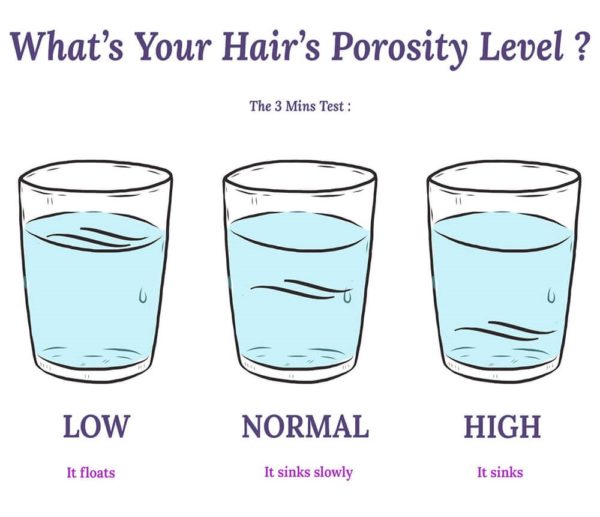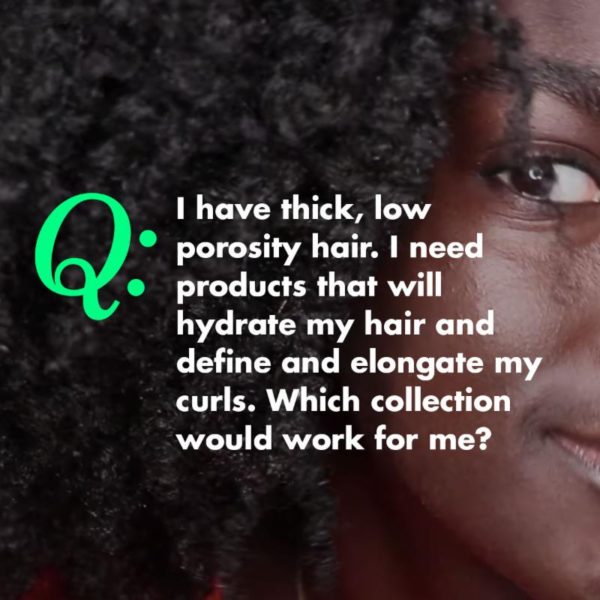Need help selecting the best products for your hair type? A good place to start is by determining your hair’s porosity level. Learning the porosity of your hair can be a major game changer for your routine and for your natural hair journey.
Now you might be asking, what is hair porosity?
Porosity deals with your hair’s ability to absorb and retain moisture on the outermost layer, known as the cuticle. The type of porosity your hair has will affect the way oil and moisture pass through it.
How do you learn what porosity type you have?
Well, it’s actually quite simple. First, you’ll need to wash your hair to remove any dirt and/or product that has built up on the surface. Then, you’ll want to fill a glass or clear bowl with water. After, take a strand of clean, dry hair and place it in the water. Leave the strand of hair in the water for about 3-5 minutes. Now, check for the results!

There are three types of porosity, and the location of your strand will determine which kind you have.
If you have low porosity, then your strand of hair will float on top of the water. This means that it takes much longer for the strand to absorb moisture because the cuticles are so tightly bound. It also means that it will take your hair a longer time to air dry.
If you have medium porosity, then your strand of hair will float somewhere in the middle, taking its time to sink towards the bottom of the glass. Medium porosity is also known as “normal” porosity because it doesn’t experience any trouble retaining moisture or air drying in a moderate amount of time.
If you have high porosity, then your strand of hair will sink towards the bottom of the glass. This means that water and moisturizing products can easily be absorbed into the strand because the cuticles have gaps and holes. High porosity hair, however, tends to break easily and air dries very quickly.
Why is it important to know your hair porosity?
Learning your porosity will help you to better manage and treat your tresses. It can also help in deciding which products will respond best to your hair, based on the ingredients.
The main hurdle for those with low porosity hair is that it can be difficult to achieve volume and to retain moisture; so let’s focus on how to address those concerns effectively. To help open up your cuticles to receive moisture, deep condition your hair with a penetrating product like our JojOba Monoi Strengthening Deep Conditioner. Though protein-free, it’s designed to repair the strand while delivering moisture deeply into the hair shaft. Using a steamer when deep conditioning can be very beneficial because it helps open up the cuticles to allow in more moisture.
For those with high porosity hair, it’s best to reduce your usage of heat overall, because heat tools have a tendency to increase porosity. If eliminating heat is not an option, be sure to use heat protectant products when you do use it, as these create a barrier between your hair and the direct heat, limiting the amount of potential damage. To help with retaining moisture, adding a leave-in conditioner and sealant to your regimen is highly recommended. Opt for products with ingredients like butters and oils; these will aid in locking the moisture into your hair.
Speaking of regimen, let’s look at the LOC and LCO methods.

It is recommended that you use the LCO method if you have low porosity. The LCO method is liquid or watery leave-in, cream, and then oil. It’s best to use light liquids and cream in your hair routine to avoid product buildup.
For high porosity, it is recommended to use the LOC method. If you choose to use a leave-in, then selecting one that is creamy is preferable. You should also be careful not to use too many heavy creams because it can weigh down the hair overall.
Which EDEN products/collections work best with each porosity type and why?
It is important to think about other factors along with porosity type when selecting one of EDEN’s products to add to your regimen. Factors like the density of your hair, protein sensitivity, and your regular hair regimen will also need to be considered.

Those with low porosity hair should use protein-free products because it is much easier for the hair to absorb and less likely to cause buildup. Products containing protein often have difficulty penetrating the cuticle, so it’s best to avoid them. However, incorporating products that have ingredients like honey and glycerin can be better fit. The Hibiscus Honey Collection is great for hydrating the hair along with restoring its elasticity. It contains both honey and glycerin + gives you the option to switch between wearing your hair straight or curly.
On the other hand, a major concern for those with high porosity hair is that it dries out too fast. It appears to absorb product immediately, which makes it hard to retain moisture. The good news is, there are products that can help to lock in that moisture. Shea Butter is a good sealant for high porosity hair so selecting an item from our Coconut Shea collection would work well for keeping your hair hydrated.
***
Now that you’ve learned a bit more about hair porosity, take some time to apply the information provided. Be sure to let us know which recommendations you found to be most helpful!

